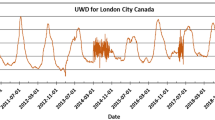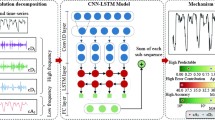Abstract
Short-term water demand forecasting is crucial for constructing intelligent water supply system. Plenty of useful models have been built to address this issue. However, there are still many challenging problems, including that the accuracies of the models are not high enough, the complexity of the models makes them hard for wide use in reality and the capabilities of models to catch peaks still have much room for improvement. In order to solve these problems, we proposed an ensemble deep learning model named STL-Ada-LSTM for daily water demand forecast by combining STL method with AdaBoost-LSTM model. After data preprocessing, the smoothed series is decomposed by STL to gain three input series. Then, several LSTM models are integrated by the AdaBoost algorithm to construct the ensemble deep learning model for water demand forecast. At last, the superiority of the proposed model is demonstrated by comparing with other state-of-the-art models. The proposed method is applied for water demand forecast using daily datasets from two representative water plants located in Yiwu, East China. All models are assessed by mean absolute scaled error (MAE), mean absolute percentage error (MAPE), mean square error (MSE), root mean square error (RMSE), coefficient of determination (R2) and Akaike information criterion (AIC). The results show that the proposed model not only improves the accuracy of the forecast, but also enhances the stability and conciseness. It is proven as a practical model with good accuracy and can be further applied in daily water demand forecast in other regions.









Similar content being viewed by others
Availability of Data and Materials
Authors have restrictions on sharing data.
References
Alvarado-Barrios L, Rodríguez del Nozal Á, Boza Valerino J et al (2020) Stochastic unit commitment in microgrids: Influence of the load forecasting error and the availability of energy storage. Renew Energy 146:2060–2069. https://doi.org/10.1016/j.renene.2019.08.032
Antunes A, Andrade-Campos A, Sardinha-Lourenço A, Oliveira MS (2018) Short-term water demand forecasting using machine learning techniques. J Hydroinformatics 20:1343–1366. https://doi.org/10.2166/hydro.2018.163
Bai Y, Xie J, Wang D et al (2021) A manufacturing quality prediction model based on AdaBoost-LSTM with rough knowledge. Comput Ind Eng 155:107227. https://doi.org/10.1016/j.cie.2021.107227
Bajany DM, Zhang L, Xu Y, Xia X (2021) Optimisation approach toward water management and energy security in Arid/Semiarid Regions. Environmental Processes 8:1455–1480. https://doi.org/10.1007/s40710-021-00537-9
Bata MH, Carriveau R, Ting DS-K (2020) Short-term water demand forecasting using nonlinear autoregressive artificial neural networks. J Water Resour Plan Manag 146:1–9. https://doi.org/10.1061/(asce)wr.1943-5452.0001165
Bramante R, Facchinetti S, Zappa D (2019) Online detection of financial time series peaks and troughs: A probability-based approach*. Stat Anal Data Min 12:426–433. https://doi.org/10.1002/sam.11411
Busari GA, Lim DH (2021) Crude oil price prediction: A comparison between AdaBoost-LSTM and AdaBoost-GRU for improving forecasting performance. Comput Chem Eng 155:107513. https://doi.org/10.1016/j.compchemeng.2021.107513
Caiado J (2010) Performance of combined double seasonal univariate time series models for forecasting water demand. J Hydrol Eng 15:215–222. https://doi.org/10.1061/(asce)he.1943-5584.0000182
Chen D, Zhang J, Jiang S (2020a) Forecasting the short-term metro ridership with seasonal and trend decomposition using loess and LSTM neural networks. IEEE Access 8:91181–91187. https://doi.org/10.1109/ACCESS.2020.2995044
Chen J, Boccelli DL (2018) Forecasting hourly water demands with seasonal autoregressive models for real-time application. Water Resour Res 54:879–894. https://doi.org/10.1002/2017WR022007
Chen L, Yan H, Yan J et al (2022) Short-term water demand forecast based on automatic feature extraction by one-dimensional convolution. J Hydrol 606:127440. https://doi.org/10.1016/j.jhydrol.2022.127440
Chen Y, Peng G, Zhu Z, Li S (2020b) A novel deep learning method based on attention mechanism for bearing remaining useful life prediction. Appl Soft Comput J 86:105919. https://doi.org/10.1016/j.asoc.2019.105919
Du B, Huang S, Guo J et al (2022) Interval forecasting for urban water demand using PSO optimized KDE distribution and LSTM neural networks. Appl Soft Comput 122:108875. https://doi.org/10.1016/j.asoc.2022.108875
Du B, Zhou Q, Guo J et al (2021) Deep learning with long short-term memory neural networks combining wavelet transform and principal component analysis for daily urban water demand forecasting. Expert Syst Appl 171:114571. https://doi.org/10.1016/j.eswa.2021.114571
Guo G, Liu S, Wu Y, et al (2018) Short-term water demand forecast based on deep learning method. J Water Resour Plan Manag 144:1–11. https://doi.org/10.1061/(asce)wr.1943-5452.0000992
Guo J, Sun H, Du B (2022) Multivariable time series forecasting for urban water demand based on temporal convolutional network combining random forest feature selection and discrete wavelet transform. Water Resour Manag 3385–3400. https://doi.org/10.1007/s11269-022-03207-z
Guo W, Liu T, Dai F, Xu P (2020) An improved whale optimization algorithm for forecasting water resources demand. Appl Soft Comput J 86:105925. https://doi.org/10.1016/j.asoc.2019.105925
Han L, Zhang R, Chen K (2019) A coordinated dispatch method for energy storage power system considering wind power ramp event. Appl Soft Comput J 84:105732. https://doi.org/10.1016/j.asoc.2019.105732
Haque MM, de Souza A, Rahman A (2017) Water demand modelling using independent component regression technique. Water Resour Manag 31:299–312. https://doi.org/10.1007/s11269-016-1525-1
He Y, Zhao Y, Hu X, et al (2020) Engineering applications of artificial intelligence fault diagnosis using novel AdaBoost based discriminant locality preserving projection with resamples. Eng Appl Artif Intell 91:103631. https://doi.org/10.1016/j.engappai.2020.103631
Heddam S, Lamda H, Filali S (2016) Predicting effluent biochemical oxygen demand in a wastewater treatment plant using generalized regression neural network based approach: a comparative study. Environ Process 3:153–165. https://doi.org/10.1007/s40710-016-0129-3
Hewamalage H, Bergmeir C, Bandara K (2021) Recurrent neural networks for time series forecasting: Current status and future directions. Int J Forecast 37:388–427. https://doi.org/10.1016/j.ijforecast.2020.06.008
Huang H, Zhang Z, Song F (2021) An ensemble-learning-based method for short-term water demand forecasting. Water Resour Manag 35:1757–1773. https://doi.org/10.1007/s11269-021-02808-4
Jowitt PW, Xu C (1992) Demand forecasting for water distribution systems. Civ Eng Syst 9:105–121. https://doi.org/10.1080/02630259208970643
Maidment DR, Miaou S-P (1986) Daily water use in nine cities. Water Resour Res 22:845–851. https://doi.org/10.1029/WR022i006p00845
Mouatadid S, Adamowski JF, Tiwari MK, Quilty JM (2019) Coupling the maximum overlap discrete wavelet transform and long short-term memory networks for irrigation flow forecasting. Agric Water Manag 219:72–85. https://doi.org/10.1016/j.agwat.2019.03.045
Mu L, Zheng F, Tao R et al (2020) Hourly and daily urban water demand predictions using a long short-term memory based model. J Water Resour Plan Manag 146:1–11. https://doi.org/10.1061/(asce)wr.1943-5452.0001276
Nguyen HP, Liu J, Zio E (2020) A long-term prediction approach based on long short-term memory neural networks with automatic parameter optimization by Tree-structured Parzen Estimator and applied to time-series data of NPP steam generators. Appl Soft Comput J 89:106116. https://doi.org/10.1016/j.asoc.2020.106116
Salloom T, Kaynak O, He W (2021) A novel deep neural network architecture for real-time water demand forecasting. J Hydrol 599:126353. https://doi.org/10.1016/j.jhydrol.2021.126353
Shabani S, Yousefi P, Naser G (2017) Support vector machines in urban water demand forecasting using phase space reconstruction. Procedia Eng 186:537–543. https://doi.org/10.1016/j.proeng.2017.03.267
Tepper JA, Shertil MS, Powell HM (2016) On the importance of sluggish state memory for learning long term dependency. Knowledge-Based Syst 96:104–114. https://doi.org/10.1016/j.knosys.2015.12.024
Voitcu O, Wong YS (2006) On the construction of a nonlinear recursive predictor. J Comput Appl Math 190:393–407. https://doi.org/10.1016/j.cam.2004.12.039
Wang Y, Gan D, Sun M et al (2019) Probabilistic individual load forecasting using pinball loss guided LSTM. Appl Energy 235:10–20. https://doi.org/10.1016/j.apenergy.2018.10.078
Xenochristou M, Hutton C, Hofman J, Kapelan Z (2021) Short-term forecasting of household water demand in the UK using an interpretable machine learning approach. J Water Resour Plan Manag 147. https://doi.org/10.1061/(asce)wr.1943-5452.0001325
Xiao C, Chen N, Hu C et al (2019) Short and mid-term sea surface temperature prediction using time-series satellite data and LSTM-AdaBoost combination approach. Remote Sens Environ 233:111358. https://doi.org/10.1016/j.rse.2019.111358
Xiong T, Li C, Bao Y (2018) Seasonal forecasting of agricultural commodity price using a hybrid STL and ELM method: Evidence from the vegetable market in China. Neurocomputing 275:2831–2844. https://doi.org/10.1016/j.neucom.2017.11.053
Xu Y, Zhang J, Long Z, Chen Y (2018) A novel dual-scale deep belief network method for daily urban water demand forecasting. Energies 11. https://doi.org/10.3390/en11051068
Zanfei A, Menapace A, Granata F et al (2022) An ensemble neural network model to forecast drinking water consumption. J Water Resour Plan Manag 148:1–15. https://doi.org/10.1061/(asce)wr.1943-5452.0001540
Zubaidi SL, Gharghan SK, Dooley J et al (2018) Short-term urban water demand prediction considering weather factors. Water Resour Manag 32:4527–4542. https://doi.org/10.1007/s11269-018-2061-y
Acknowledgements
The authors would like to thank Zhejiang Provincial Hydrological Management Center for providing the data used in this study. Editor and reviewers are greatly acknowledged for their constructive comments.
Funding
This study was funded by the Major Project of the Natural Science Foundation of Zhejiang (grant number LZ20E090001) and National Key Research and Development Program (grant number 2019YFC0408805).
Author information
Authors and Affiliations
Contributions
Yue-Ping Xu: Conceptualization, Supervision, Reviewing and Editing; Jing Liu: Conceptualization, Methodology, Original draft writing and Visualization; Xin-Lei Zhou: Data analysis, Methodology and Visualization; Lu-Qi Zhang: Data analysis, Visualization, Reviewing and Editing.
Corresponding author
Ethics declarations
Ethical Approval
Compliance with Ethical Standards Conflict.
Consent to Participate
Informed consent was obtained from all individual participants included in the study.
Consent to Publish
The participant has consented to the submission of the case report to the journal.
Competing Interests
The authors declare that they have no known competing financial interests or personal relationships that could have appeared to influence the work reported in this paper.
Additional information
Publisher's Note
Springer Nature remains neutral with regard to jurisdictional claims in published maps and institutional affiliations.
Rights and permissions
Springer Nature or its licensor (e.g. a society or other partner) holds exclusive rights to this article under a publishing agreement with the author(s) or other rightsholder(s); author self-archiving of the accepted manuscript version of this article is solely governed by the terms of such publishing agreement and applicable law.
About this article
Cite this article
Liu, J., Zhou, XL., Zhang, LQ. et al. Forecasting Short-term Water Demands with an Ensemble Deep Learning Model for a Water Supply System. Water Resour Manage 37, 2991–3012 (2023). https://doi.org/10.1007/s11269-023-03471-7
Received:
Accepted:
Published:
Issue Date:
DOI: https://doi.org/10.1007/s11269-023-03471-7




